Most popular Hindu deities
Hinduism is essentially a monotheistic religion. Still, Hindus worship numerous gods and goddesses. All of these gods and goddesses are thought to be the manifestations of the Supreme Being or Brahman.
The most important deities of Hinduism are the Trinity – Brahma (the creator), Vishnu (the preserver) and Shiva (the destroyer). This, however, does not mean that they are the most popular deities. Of the Holy Trinity, Brahma is the least popular and Shiva is the most popular. Vishnu is not exactly popular as Vishnu, but two of his avatars – Rama and Krishna – top the popularity charts. Who is more popular – Rama or Krishna? Well, that is impossible to say, but my personal favorite is Krishna.
Krishna may be the most popular deity in many parts of India but he faces some serious competition from Ganesh. Ganesh (aka Ganapati, Vinayaka or Ganesha) is the son of Shiva and Parvathi. He is more popular than his father and mother. In Maharashtra he is the supreme lord. Hindus worship the God in both male and female forms. Goddess Lakshmi is actually more popular than her consort Vishnu. She is the goddess of wealth – both spiritual and material. Likewise, Durga the consort of Shiva enjoys greater popularity than him.
Here are the most popular Hindu deities in no specific order.
Ganesha / Ganesh
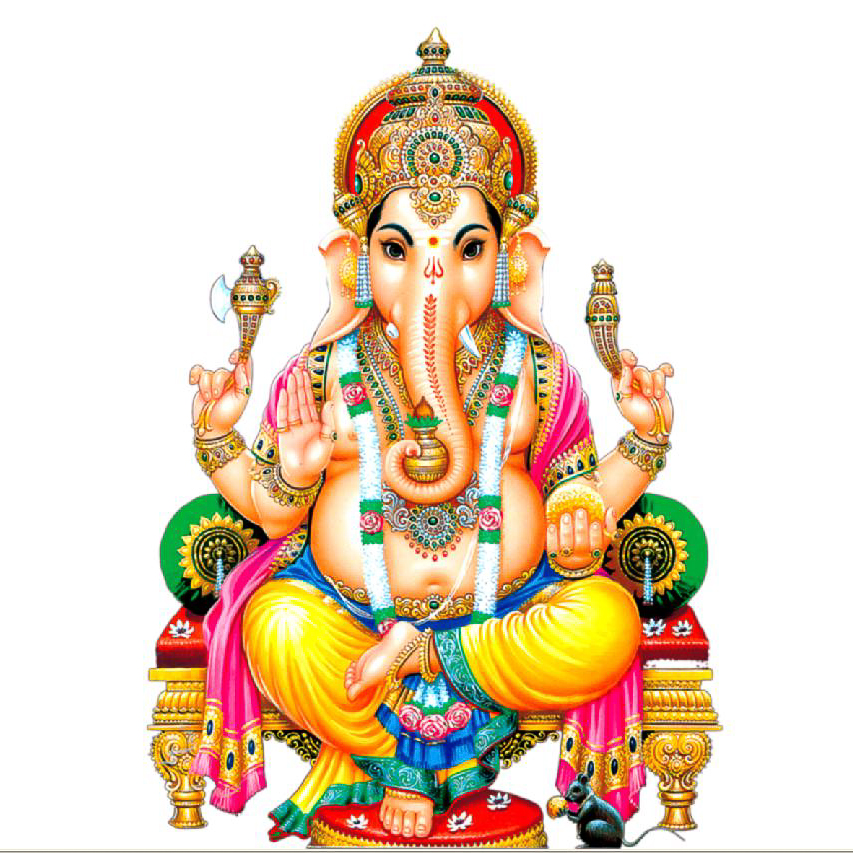
Lord Ganesha – Worshipped all over India, Ganesha is as popular as Krishna. In some parts of India he is the supreme deity.
He is the elephant headed deity who rides the humble mouse. Ganesha is easily the most recognizable Hindu deity. He has the head of an elephant and the body of a human being. He is a foodie and likes to gorge on sweets. You can guess that from his pot belly. He is worshipped all over India. In some states like Maharashtra, he is the supreme deity. Almost all Hindu temples have a shrine dedicated to Ganesha. Even if he isn’t the principle deity of the temple, offerings are first made to him because he is the remover of obstacles and destroyer of evils. Hindus seek his blessings before they start working on a new venture. Ganesha is also worshipped as the god of knowledge and wisdom.
Ganesha is the son of Lord Shiva and his consort Parvathi. He is closer to his mother than his father. The lord of success, he has a curved trunk and big ears. Ganesha is hugely popular with kids as well as adults. Actually, his unique form has played an important role in making him such a popular deity. Ganesha’s elephant head symbolizes the soul or Atman and his human body signifies our earthly existence or Maya. In Hindu philosophy the soul is the supreme reality
Shiva
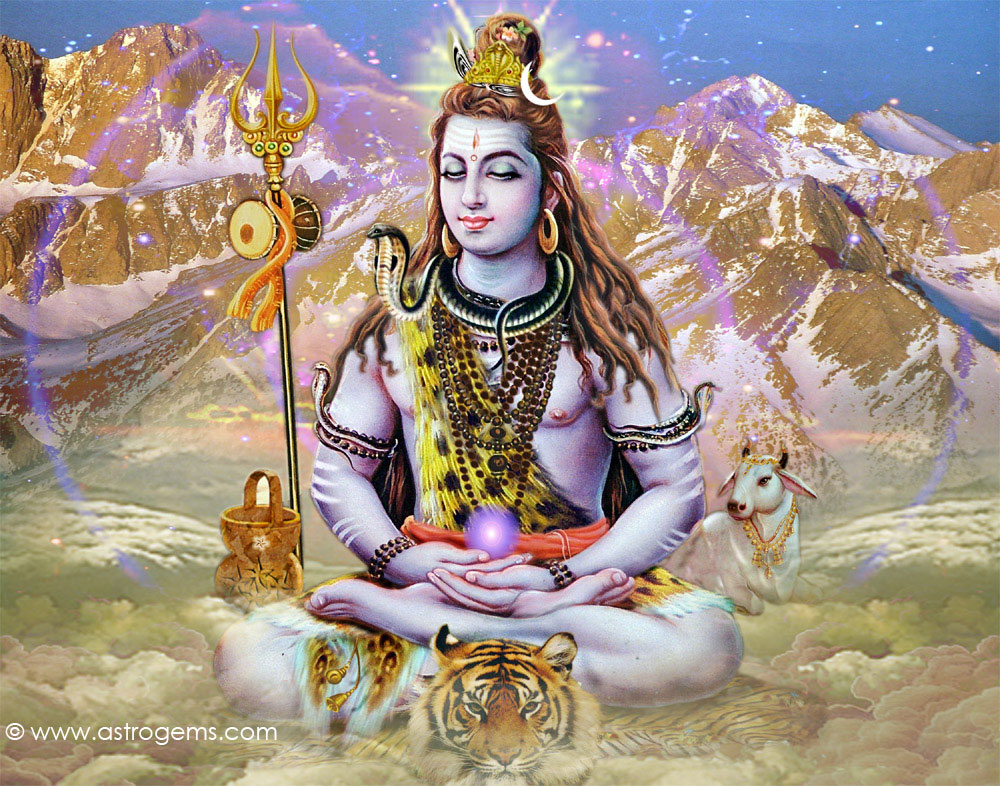
Lord Shiva – He is the biggest ascetic who prefers to spend much of his time in meditation. His consort Parvathi/Durga plays an important role in keeping him interested in the affairs of the world.
The most powerful of all Hindu gods, Shiva is the lord of death and dissolution. He has numerous names – Mahadeva, Pashupati, Nataraja and Vishwanath. He is often worshipped as a phallic symbol called Shiva Lingam.
Shiva is worshipped all over India. While he can’t be called the most popular Hindu deity, he commands utmost respect here. His abode is the Kailash in the Himalayas. The higher you go up in the north, his prominence also increases. Shiva is the biggest ascetic. He is also aloof. It is his wife Parvathi who keeps him interested in worldly affairs.
Durga
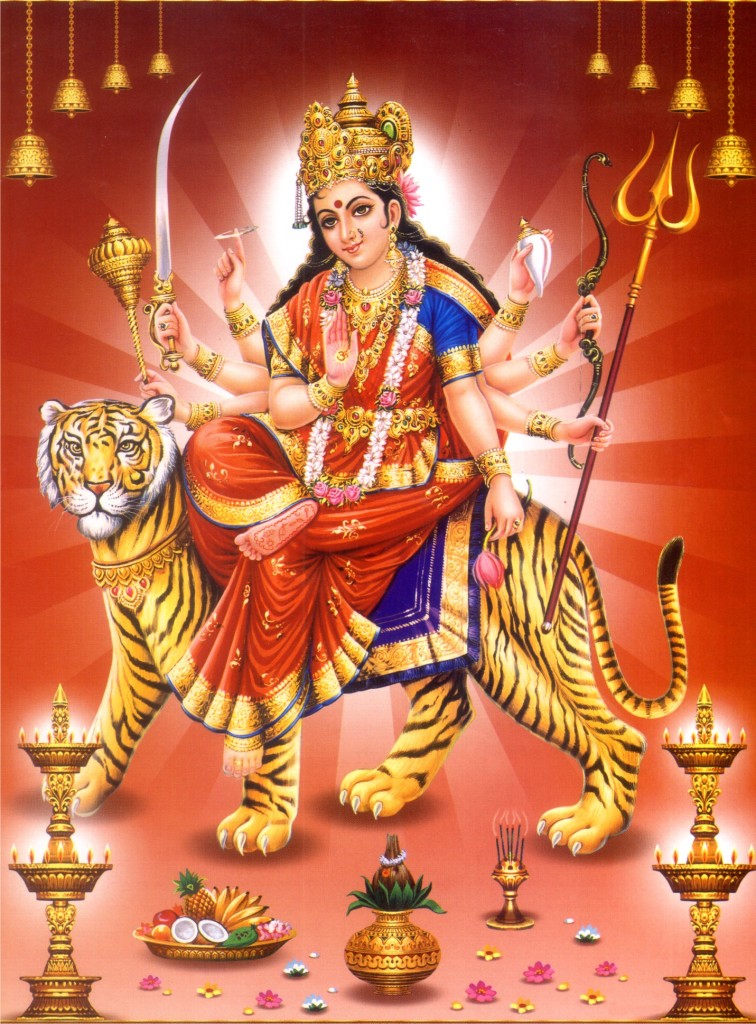
Goddess Durga – She is the destroyer of the wicked and the protector of the righteous. The whole of India worships her during Navaratri.
Like Lakshmi, Durga is another manifestation of the Mother Goddess. She has numerous names – Parvathi, Amba, Chamundi, Chandika, Bhavani, Gauri. She represents the fiery side of the Mother Goddess. While Lakshmi is the consort of Vishnu, Durga is the consort of Shiva. Actually, Durga is more famous as Parvathi, but there are more Durga temples than Parvathi temples in India. Durga is the Shakti (power) behind Shiva. She has numerous arms and holds various weapons in all of them. She is always depicted as riding a lion. Durga is the protector of the righteous and the destroyer of the wicked.
Durga is worshipped all over India in various forms. She is the most popular deity in Bengal where she is worshipped as Durga and Kali. Navaratri, the most important of all Hindu festivals, is celebrated in honor of the Mother Goddess. During these nine days, the Goddess is worshipped in all of her forms. Navaratri (nine nights; actually this is a 10-day festival) is the most important festival for Hindus because it is the only festival that is celebrated by all Hindus at the same time all over the world. In North India, the first nine days of this festival are meant for rigorous fasting and the 10th day is meant for the celebration of the good over the evil. In South India, Navaratri enjoys the same popularity but it is celebrated in different ways. In Bengal, much of Navaratri constitutes Durga Puja.
Kali
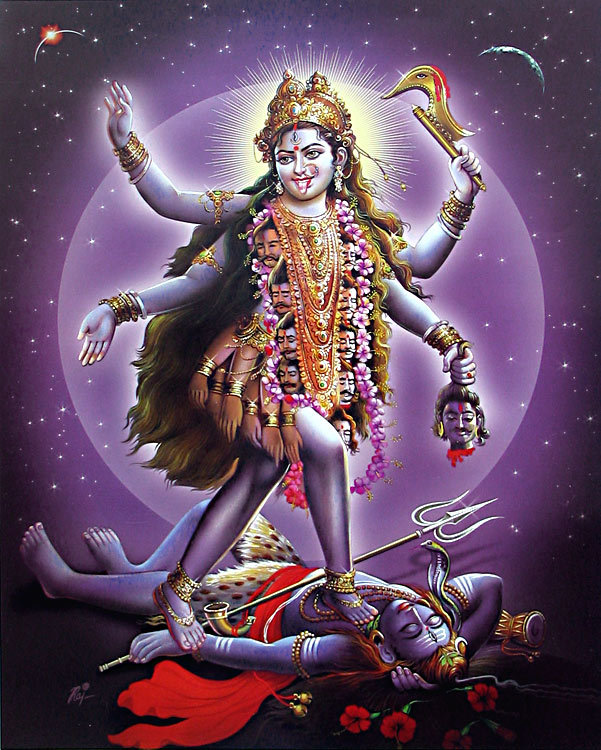
Goddess Kali – She is shown here as standing on her husband Shiva. Kali represents the female energy or prakurti (nature) and Shiva the male energy or Purusha (man). This image suggests that nature is superior to man.
Kali is the most ferocious form of Durga. She is believed to have been born from the brow of Durga during one of her battles with Asuras. Kali has the fiercest features amongst Hindu deities. Her eyes are red and her tongue protrudes from her mouth. What is more, her face and breasts are sullied with blood. She is almost always depicted as standing on Shiva, with one foot on his thigh and the other on his chest. In Hindu mythology Shiva is the male energy (Purusha) and Shakti (Durga or Kali) the female energy or nature. Shiva lying at the feet of Kali shows the supremacy of nature over man. Without her even Shiva is helpless.
In spite of her fearful appearance, Kali is one of the most loved deities of Hinduism. In Bengal, she is the most popular deity. In other parts of the country too, she is worshipped with utmost reverence and love. The most popular Kali temples are in Bengal and Assam. The Kamakhya Temple in Assam is a seat of tantrik practices. The Kali temples at Kalighat and Dakshineshwar are famous all over the world. Some of the biggest exponents of Hinduism were ardent devotees of Kali. Ramakrishna Paramhamsa and his disciple Swami Vivekananda are famous examples.
Krishna

The eternal flutist – None will beat Krishna in the popularity contest. He has influenced every aspect of Indian life from its art and literature to culture and philosophy.
None, except maybe Ganesha, can beat Krishna in the popularity contest. No other deity has had such profound impact on India’s culture, literature, art, music and philosophy. Krishna is the ultimate lover, the best friend and the most devoted son. He is the most complete incarnation of Vishnu. He is also the most loved. This blue-skinned ‘butter thief’ (he used to steal and butter when he was a child) is worshipped in his infant form as well as in his adult form. He was a prince born in a prison. He was raised by a family of cowherds and spent his childhood herding cattle and playing with the pretty girls of Vrindavan. He wears yellow, has a peacock feather in his hair, a flute in his hand, and a mischievous smile on his lips. For some he is an enigma; for others he is their best buddy. Every Indian mother aspires to have a child like him and every girl in this part of the world wants a lover like him. He can be a master strategist and a playful buddy at the same time. He is the Supreme Truth for most Hindus. Krishna is worshipped all over India. Some of the most popular temples in the country are dedicated to him.
Rama

Lord Rama with Sita – This adorable image depicts Sita’s wedding with Rama. Rama is the perfect avatar of Vishnu and has none of the shortcomings typically associated with Krishna
Rama is more popular in the North than in the South where you can’t find many temples dedicated to him. Rama is the 7th avatar of Vishnu. He lived in Tretayug. Krishna is the 8th avatar. Rama is considered as the perfect avatar of Vishnu. He possessed no shortcomings. He is portrayed as the best son, the best brother, the best husband and the best king. He is one of the most popular Hindu deities. Rama is believed to be an actual historical figure. Ramayana, the first epic, is the story of his exploits. Like Krishna, Rama has blue skin. Vishnu also possesses blue skin.
He was a warrior and always carried a bow and arrow in his hands. He was also an indulgent brother and a devoted husband. In his pictures he is always shown as standing between Lakshmana (his brother) and Sita (his wife). Lord Hanuman is an ardent devotee of Rama.
Hanuman

Lord Hanuman – He is the epitome of courage and loyalty. In India, you will find a Hanuman shrine wherever you look.
Hanuman is the favorite deity of millions of Hindus. He considers himself a devotee of Lord Rama. Hanuman is the son of wind (Pavan/Maruthi) and many consider him to be an incarnation of Shiva. Hanuman is one of the central characters of Ramayana. He also makes several appearances in Mahabharata.
Why is he so popular? This legendary ape is the epitome of courage, loyalty, strength and selflessness. A lot of Hindus fast on Tuesdays and sometimes on Saturdays in honor of Hanuman. It is also a common practice among Hindus to chant his names (Hanuman Chalisa). Hanuman enjoys the same popularity as Rama. Actually, he has more shrines dedicated to him than any other Hindu God. Hanuman teaches us the power of devotion. He devoted all of his energies towards the worship of Rama. This undying devotion freed him all types of mental and physical fatigue and made him the strongest and wisest ape.
Vishnu
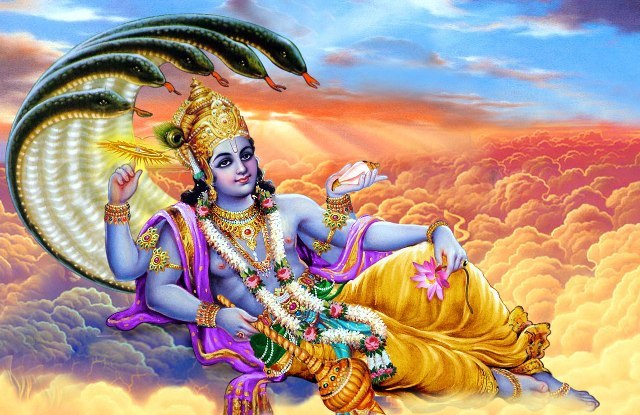
Lord Vishnu – He is a peace-loving deity who has a special fondness for his devotees. He takes birth on earth whenever there is a decline of virtue. His avatars are more popular than him.
Vishnu is the preserver. He is a peace-loving deity who has a special fondness for the righteous. Some of the wealthiest temples in the country are dedicated to Vishnu; however, Vishnu isn’t the most popular. His avatars enjoy greater prominence. As the preserver of this universe, Vishnu is responsible for maintaining order, justice and truth. When these values are under threat, he takes birth on earth in a human or animal form. Hindus believe that Vishnu has 10 avatars. The first was Matsya (fish). Rama was the 7th and Krishna the 8th. Some people believe that Buddha was the 9th avatar of Vishnu. The 10th avatar Kalki is yet to be born. The Lord Venkateshwara Temple at Thirupathi in Andhra Pradesh is the most famous Vishnu temple in India. It is also one of the wealthiest temples. Here Vishnu is worshipped as Balaji or Venkateshwara. The Shree Padmanabha Swami Temple at Thiruvananthapuram is not as famous as the Balaji temple at Thirupathi but it made international headlines recently when gold and jewels worth over a trillion US dollars were found in its vaults.
Vishnu is often depicted as reclining on Anantha – the snake with several heads – floating on the waters of a mythical ocean called Palazhi. His abode is Vaikundam. Garuda, the eagle, is the vehicle of Vishnu. This mighty bird is known for his strength, courage and wisdom. Vishnu is also known as Narayana and Hari.
Lakshmi

Goddess Lakshmi – the word Lakshmi is synonymous with every auspicious. She is one of the most loved deities of Hinduism.
The consort of Vishnu, Goddess Lakshmi means good luck to Hindus. She is the goddess of prosperity and is shown as standing or sitting on a full bloomed lotus and showering gold coins from her hand. Images in which she is shown as sitting as opposed to standing are considered particularly auspicious. Devotees want the goddess to stay in their home/office and shower blessings on them. The worship of Lakshmi forms an important part of Diwali celebrations.
Lakshmi is a popular name for Hindu girls. Actually, this name is synonymous with everything beautiful, good and auspicious. When Hindus use the word Lakshmi they are not always referring to the Goddess. Sometimes they are simply referring to good luck or prosperity.
Lakshmi is a domestic goddess. The worship of Lakshmi as a goddess is an individual practice. Most Hindu homes have at least one image of Lakshmi. Most of them will also have a drawing of two little feet at the entrance. These feet represent Lakshmi. Everyone wants the goddess to enter their home.
In spite of her huge popularity in art, culture and religion, there aren’t many temples dedicated to Lakshmi. This is probably because Hindus worship the female form of the Supreme Power as Mother Goddess or Adi Parashakti. She is even more powerful than Brahma, Vishnu and Shiva. Actually they seek her help when they can’t annihilate a demon. There is no evil force that the Mother Goddess cannot destroy. The goddesses Lakshmi, Parvathi, Durga, Kali, Amba, Bhavani and Saraswathi are all considered as the various manifestations of the Mother Goddess. The Mother Goddess is called Bhagavathy, Mata (mother in Hindi) or Amma (mother in most South Indian languages). There are numerous Bhagavathy temples in India. In these temples, the Goddess is worshipped in all of her forms.
Saraswathi

Saraswathi is the goddess of music, art, literature and learning. She is depicted as playing the stringed instrument called Veena.
Saraswathi is the goddess of knowledge and learning. She is the consort of Lord Brahma. She is one of the many forms of the Mother Goddess and is worshipped with great devotion during Navaratri. There aren’t many temples dedicated to her, but she is worshipped in all temples as Bhagavathy or Mother Goddess. Hindus believe that her blessings are required to excel in academics and arts. In South India, there is a ceremony called Vidyarambham (the beginning of learning). It is observed on Vijayadashami (the tenth day of Navaratri). On this day parents will take children aged between 2 and 3 years to a nearby temple and the priest will write the letters of the alphabet and the names of gods and goddesses on their tongue. This process initiates them into the world of learning.